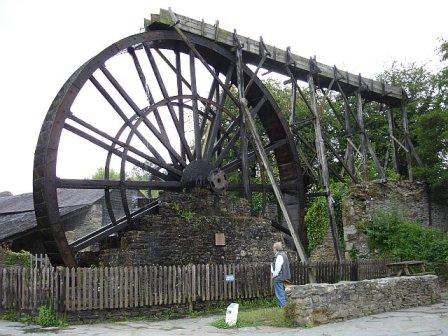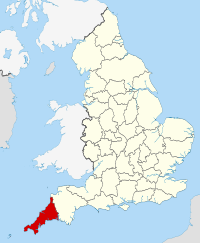
Morwellham Quay Waterwheel - © Penny Mayes
The Cornwall and West Devon Mining Landscape contains a number of historically significant & authentic mining landscapes that form the basis of the World Heritage Site. The sites are located both in the counties of Cornwall and Devon and are significant for historical, technological and social reasons, the importance of the mining landscapes in the two counties has been recognised by UNESCO with the World Heritage Site status that was awarded to the sites in 2006. Visitors to the region can see a number of tourist attractions in the area along with learning more about the rich history and heritage of the area that brought the area to the forefront in the 18th and 19th centuries.
Overview
The Cornwall and West Devon Mining Landscape World Heritage Site is located across ten main areas in the English counties of Devon and Cornwall. It was during the 18th and 19th centuries that the mining landscapes here came to the fore, the landscape of the area had undergone a rapid change with the advent of tin and copper mining that the areas became famous for. There are a number of underground mines, new towns, harbours and ports and a range of related industries that helped to power the growth of industry here, at one stage over 60% of the world's copper supply came from here.
The region has substantial remains from the mining landscape that are indicative of the great contribution that was made to industry here. The region made a significant contribution to the Industrial Revolution in the UK and became a leader in mining technology and innovation. The technology produced here was at one stage at the forefront of mining technology and expertise, examples include mining equipment and engines were produced here and exported across the world.
The World Heritage Site in Cornwall and West Devon consists of ten areas, the landscapes of these areas represent former mining districts, associated industries ad settlements, the areas are:
Camborne & Redruth Mining District
Caradon Mining District
Gwennap Mining District, Kennall Vale and Perran Foundry
Luxulyan Valley & Charlestown
Port of Hayle
St Agnes Mining District
St Just Mining District
Tamar Valley & Tavistock
Tregonning and Trewavas Mining District
Wendron Mining District
Gwennap Pit is located in Redruth in Cornwall and is an open air amphitheatre with extra ordinary acoustic properties, it was remodelled back in 1806 and has been in tat guise ever since. The pit measures some 85 metres in diameter, with tiered grassy seating. During the 18th century many people from the surrounding mining towns would come here to listen to preacher John Wesley give his sermons. There is a chapel adjoining that was built in 1837 and a visitor centre for tourists.
Geevor Tin Mine is located on the west coast of Cornwall. It is the site of the largest preserved mine in the UK, here visitors can gain an insight in to Cornwall's mining heritage and learn more about the history of the mine and the local area. Geevor was a working mine until 1990, since that time it has become a museum and offers a number of underground tours for visitors in the 18th and 19th century mines.
Levant Mine and Beam Engine is located in Pendeen, Cornwall and is currently owned and looked after by the National Trust. Here visitors will find the oldest working steam beam engine in Cornwall, the Levant engine is stationed engine house located on the edge of the cliffs. Visitors can see the old engine in action again after 60 years idle it has been restored by volunteers and offers visitors a great experience. There are underground tours for visitors to experience the mine and videos that illustrate the storey of both the mine and the miners that worked here.
King Edward Mine is in Camborne in Cornwall and is the oldest complete mine site in Cornwall. Part of the site is open to the public, the site also contains a museum that gives more information on the mine, local history, experiences and artefacts. Visitors can go on a guided tour through the tin mill and see a demonstration of the range of processing machinery.
Morwellham Quay is located close to Tavistock in Devon and contains an interesting museum and visitor centre. Here visitors can see the past come back to life with staff dressed from the 1860s will help transport visitors back to the period, visitors can get in to the spirit of things if they wish by trying on the replica costumes! The site is located between hills and cliffs and makes for pleasant surrounds and nice scenery to enjoy. A visitor favourite is the narrow-gauge Mine Railway. Visitors can travel train along the banks of the River Tamar and then go deep underground in the George & Charlotte copper mine. Inside the mine there are displays that show hw difficult and challenging the conditions were for the workers here.
A visit to the Victorian farm and nature reserve offers the opportunity to escape to the tranquillity of the English countryside and enjoy the wildlife. Morwellham Quay has over 200 acres for visitors to explore.
A visit to the various sites that fall under the WHS offers visitors the chance to visit an area of rich heritage and historical significance. With a range of sites and a range of visitor attractions to explore, visitors can also enjoy the natural scenery along the way with plenty of places in Devon and Cornwall offering great views and a relaxing environment to travel in.
How To Get There
The World Heritage Sites in Cornwall & West Devon are accessible by car and public transport:
By Car:
The motorway network can take drivers close to Exeter in Devon, from London take the M4 westbound and change on M5, the M5 goes all the way until the junction with the A30 and take the A30 towards Cornwall. The A30 and A38 take you to a number of the WHS in the area.
By Train:
First Great Western Trains offer a number of services to Devon and Cornwall from other towns and cities in the UK and locally. From London Paddington there are services to Cornwall including to Penzance on the western coast.
South West trains offers train services from London Waterloo to Exeter Station, the journey time is approx 3 hours and 45 minutes.
By Bus/Coach:
National Express offers coach services to places across Devon and Cornwall that include Exeter and Penzance, there are services from many towns and cities across the UK such as Bristol, Birmingham and from London.
The local bus network in Cornwall is operated by First Devon and Cornwall and Western Greyhound offering local bus services to a number of sites.
Contact Details
Address:
Cornish Mining World Heritage Site
The Percuil Building
Old County Hall
Truro
Cornwall
TR1 3AY
United Kingdom
Telephone: + 44 (0)1872 322586
Website: Cornish Mining
Facilities and Information
Further Information:
Opening Times:
Geevor Tin Mine:
Mon to Sat: 09.00 to 16.00 (Easter to end of Oct)
Mon to Sat: 09.00 to 15.00 (Nov to end of March)
Adults: £8.50 approx, Children: £4.50 approx, Concessions: £7.50 approx, Family Tickets: £25.00 approx.
Levant Mine and Beam Engine:
11.00 to 16.00/17.00
Note: Is closed on various days each week depending on the month. See National Trust for the latest information.
King Edward Mine:
10.00 to 17.00 (last entry at 16.00)
Note: Is closed on various days each week depending on the month. See: King Edward Mine for the latest information.
Adults: £4.50 approx, Children: £1.00 approx (Under 5 Free).
Morwellham Quay:
Mon to Sun: 10.00 to 17.00
Admission cost: Free to see the quays and stroll around.
Morwellham Day Tickets:
Adults: £8.50 approx, Children: £6.00 approx, Concessions: £7.50 approx, Family Tickets: £22.00 approx.
Map
View Larger Map
For Local Search and Directions see: Cornwall & East Devon Map
Tips & Other Considerations
There may be some variations on the opening hours of the various visitor attractions, depending on the time of year and other factors. Visitors are advised to double check each attraction they wish to see before going & avoid disappointment.
When travelling follow safety tips & remain alert and aware of your surroundings and environment. Ensure your belongings in particular your wallet/purse and valuables are hidden away from public view (especially at tourist attractions & places with crowds). If you have a bag try to use a shoulder bag with a good quality, strong strap, that is put across your shoulder not on your shoulder making it more difficult for anyone to take your bag.
If you are travelling by car to either Devon or Cornwall, ensure you are well prepared with maps and Sat Nav to aid your journey, particularly if you are not familiar with the local area and roads. It is recommended drivers exercise caution and drive safely. Use the Journey & Route Planner for door to door directions for public transport and car journeys.
If you are looking for local car parking at the various WHS sites, ensure you fully understand the rules, regulations & charges for car parks and street parking before you park your car. The rules & regulations can be complex if you are not sure it is wise not to park there.
If you are travelling by public transport, check for service updates prior to beginning your journey for any delays, disruption or cancellations to services that may impact on your journey. Ensure you have the service timetables for the trains, buses and coaches. Remember when the last services are and ensure you make it to the train/bus/coach stops well in time to avoid missing the service.
Disclaimer: The information given in on this website is given in good faith and to the best of our knowledge. If there are any discrepancies in no way do we intend to mislead. Important travel details and arrangements should be confirmed and verified with the relevant authorities.


